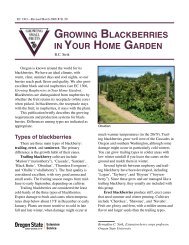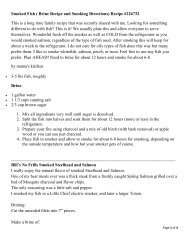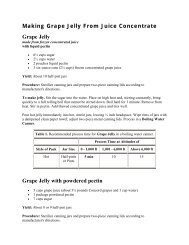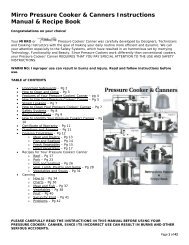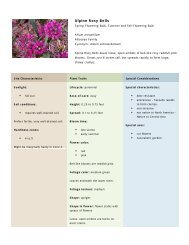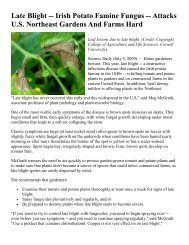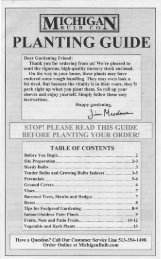Strawberry and Raspberry Pest Management in Wisconsin
Strawberry and Raspberry Pest Management in Wisconsin
Strawberry and Raspberry Pest Management in Wisconsin
You also want an ePaper? Increase the reach of your titles
YUMPU automatically turns print PDFs into web optimized ePapers that Google loves.
Table 5. Disease resistance rat<strong>in</strong>gs a of strawberry cultivars based on observations <strong>in</strong><br />
Wiscons<strong>in</strong> (cont<strong>in</strong>ued)<br />
Cultivar<br />
Angular<br />
leaf spot Fruit rots Leaf scorch Leaf spot<br />
Powdery<br />
mildew Red stele<br />
Verticillium<br />
wilt<br />
Itasca — — R T R R —<br />
Jewel VS R R R R S S<br />
Kent VS S VS VS T S S<br />
Mesabi — T T T T R —<br />
Mira S T R R R R S<br />
Sable VS S T T S R —<br />
Seneca — T S T — S S<br />
Sparkle S S–I I S R S–R b S<br />
Tribute — T T T R VR T–R<br />
Tristar T T T T R R R<br />
Wendy S T T S T T S<br />
W<strong>in</strong>ona VS T R T T R —<br />
a VS = very susceptible; S = susceptible; I = <strong>in</strong>termediate reaction; T = tolerant (disease symptoms evident,<br />
but with little detrimental effect on the plant or yield); R = resistant (the disease does not occur on this<br />
cultivar or only to a very small degree); VR = very resistant; — = unknown or untested.<br />
b Disease reaction depends on races of the pathogen. For more <strong>in</strong>formation, contact Brian Smith<br />
(715-425-3851) or Patty McManus (608-265-2047).<br />
PREPLANT SOIL FUMIGATION To help ensure a productive plant<strong>in</strong>g, advanced plann<strong>in</strong>g <strong>and</strong><br />
preparation of the site prior to plant<strong>in</strong>g are recommended. Although<br />
generally not recommended <strong>in</strong> Wiscons<strong>in</strong>, preplant soil fumigation may<br />
be beneficial where populations of soilborne pests are known to be<br />
high. Soil fumigants can help control soilborne fungi (e.g., Verticillium,<br />
Phytophthora), nematodes, soilborne <strong>in</strong>sects, <strong>and</strong> weeds <strong>and</strong> also<br />
encourage vigorous root growth <strong>and</strong> plant establishment. Fumigate <strong>in</strong><br />
late summer or early fall the year before plant<strong>in</strong>g. At plant<strong>in</strong>g, use<br />
pathogen-free plants obta<strong>in</strong>ed from a reputable nursery.<br />
DISEASE NOTES<br />
Note: Most fumigants are restricted-use pesticides <strong>and</strong> can be applied<br />
only by certified applicators. Custom applicators are available for hire.<br />
Angular leaf spot Angular leaf spot, caused by the bacterium Xanthomonas fragariae, is a<br />
sporadic disease <strong>in</strong> Wiscons<strong>in</strong> that can severely damage foliage <strong>and</strong><br />
fruit. The disease is favored by cool, damp weather. Early symptoms on<br />
lower leaf surfaces are small water-soaked spots bordered by t<strong>in</strong>y ve<strong>in</strong>s.<br />
The spots appear dark green when viewed from above, but translucent<br />
<strong>and</strong> light green to yellow when held up to light. Under moist<br />
conditions, the spots ooze a milky substance which, upon dry<strong>in</strong>g, forms<br />
a th<strong>in</strong>, scaly film. The bacteria-laden exudate is readily spread by<br />
splash<strong>in</strong>g water, so avoid us<strong>in</strong>g spr<strong>in</strong>klers to irrigate plant<strong>in</strong>gs <strong>in</strong>fected<br />
with angular leaf spot. The pathogen overw<strong>in</strong>ters <strong>in</strong> dead leaves;<br />
remov<strong>in</strong>g leaf debris from the bed after renovation will reduce<br />
<strong>in</strong>oculum for the follow<strong>in</strong>g year. Most cultivars appear susceptible to<br />
angular leaf spot; the cultivar Honeoye appears to be especially<br />
susceptible.<br />
Chemical control of bacterial diseases is <strong>in</strong>consistent. However, copper<br />
compounds (e.g., copper ammonium carbonate, copper hydroxide, <strong>and</strong><br />
copper sulfate) are the chemicals most effective aga<strong>in</strong>st angular leaf<br />
spot. If the disease was present last year, apply copper sprays as soon<br />
as growth starts <strong>in</strong> the spr<strong>in</strong>g. Additional applications at weekly<br />
<strong>in</strong>tervals may be necessary if the weather is cool <strong>and</strong> humid. Plants are<br />
17




